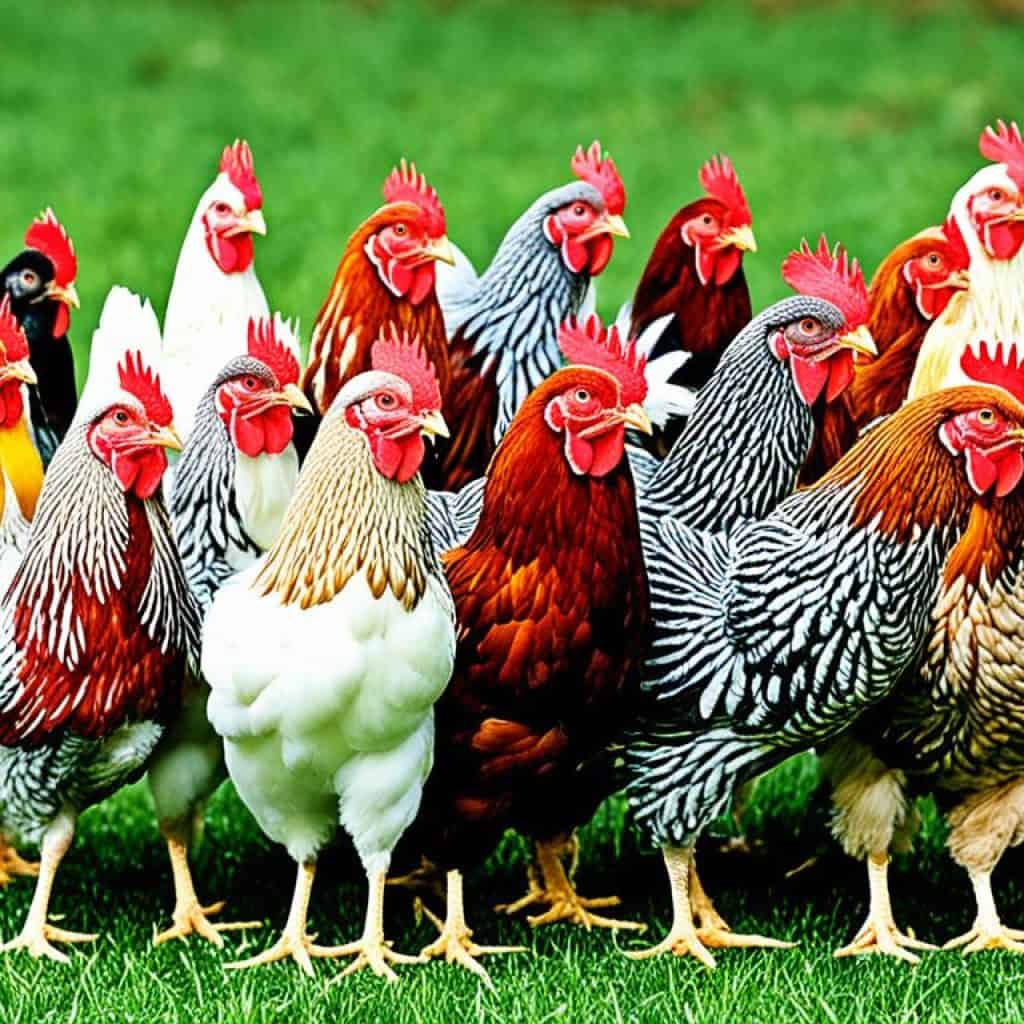Want to build your own backyard flock of healthy, vibrant Philippine chicks? Whether you’ve got a lot of experience or you’re just starting, this guide is perfect for you.You’ll learn everything from setting up the brooder to keeping your chicks healthy and safe. Are you curious about the differences between raising chicks for their eggs or meat? We’ll explore that too!
Key Takeaways
- Proper brooder setup, including temperature, bedding, feeders, and waterers, is crucial for chick health and survival.
- Selecting the right Philippine chicken breed – whether for eggs, meat, or dual-purpose – will determine the focus of your backyard flock.
- Maintaining strict biosecurity measures, from quarantining new additions to cleaning the coop, helps prevent disease and pest issues.
- Incorporating chickens into your garden can provide benefits like fertilization, pest control, and cleanup of plant debris.
- Staying proactive and addressing challenges promptly is key to overcoming common obstacles in raising Philippine chickens.
Prepping the Brooder
The brooder is a cozy home for your Philippine chicks for 4-5 weeks. To prepare, choose the right brooder and add comfy bedding. Don’t forget to fill the feeder and waterer and set up the heat source. This area must be safe, warm, and stocked with food and water for your chicks.
Selecting the Right Brooder
Put soft paper towels at the bottom of the brooder for the chicks.1 Use Grubbly’s Little Pecks Feed in the feeder for complete nutrition1. Set up a shallow waterer, making sure it’s not too deep for the chicks1. You might also want to add probiotics or apple cider vinegar to boost the chicks’ health.
Setting Up the Bedding, Feeders, and Waterers
Prepare the brooder early to prevent diseases in your chicks2. Think about using an automatic waterer to benefit your flock2. Getting ready for new birds ahead of time saves you time and money later2.
Choosing the Appropriate Heat Source
Decide between a heat lamp and a radiant heater for warmth. Radiant heaters are the best, offering safety and natural warmth for baby Philippine chicks. Place the heat source to create a warm side and a cool side in the brooder. This way, the chicks can choose their temperature.
Introducing Food, Water, and Heat to Chicks
With the brooder all set, let’s help the chicks settle in. Start by showing them their food and water. Gently put each chick’s beak in the water so they know where to drink. Then, spread some starter feed near the feeder to spark their interest.3 For very young chicks, a bit of sugar water will jumpstart their digestion.
Providing Sugar Water for Young Chicks
Chicks that have just arrived or are very young should get sugar water. Mix a little honey in warm water (about 2 tsp of honey in 1 cup). Dip each chick’s beak in the water so they can drink some.3 This gives them energy and helps them start finding their food and water.
Guiding Chicks to the Heat Source
Once the chicks have eaten and drunk, they need to find the warm spot. If there’s a heat lamp, guide them closer to it.3 If you’re using a radiant heater, show them to go beneath it. Keep an eye on the chicks at first to make sure they’re healthy and warm enough.
Setting Up the Proper Heat Source
Chicks can’t control their body heat at first, so they need extra warmth.3 Place a heat lamp 18 inches above the ground to keep it at 95°F. This helps them stay warm without overheating. As they grow, slowly move the lamp up 3 inches each week. This shows them how to manage on their own over time.
Using Radiant Heaters for Brooding
Radiant heaters provide consistent heat that’s good for chicks.4 They are safer and mimic the sun’s warmth better than heat lamps. Keep the brooder above 55°F so chicks can trust moving around. Also, lift the heater as chicks get bigger.
Monitoring Chick Behavior for Heat Needs
It’s important to keep an eye on how the chicks act to know if they’re warm or cool enough.3 If they crowd under the heat and chirp loudly, they may be cold. If they lie down and breathe heavily, they’re too hot. You then adjust their heat source to make sure they’re just right. This helps in keeping them happy and well.
Troubleshooting Heating Issues
Watch out for a few signs that show if your chicks are warm enough. If they stay close to the heat, making lots of noise, they might be cold.3 Chicks that lie out, gasping, are probably too warm.5 You should change how warm their area is to fit their needs. Keep an eye on them to make sure they’re okay. The optimal temperature for chicks starting is 95°F. Lower this by 5°F each week until they’re not interested in the extra heat anymore.3
Chicks should have extra heat for their first month or so.3 The best temperature for their space is 55-60°F.3 If using a heat lamp, the floor’s heat should be around 95°F.3 Move the lamp up about 3 inches weekly. This helps them get used to needing less warmth over time.3 It’s safer and healthier to use radiant heaters instead of heat lamps. Once chicks have grown full feathers, they won’t need the extra warmth.3 Look out for signs they’re too hot, like staying under the lamp and loud cheeping.3
A chicken’s body normally runs hot, around 104°F.5 Some chickens are better at handling the heat because of how much skin they show, called combs and wattles.5 Don’t crowd the coop, or they will start fights and might even hurt each other.5 Give each chicken at least 8 square feet, and they should be okay. For heat relief, fans and better ventilation are key. Misters can make the air cooler by a lot in hot places.5 Putting cold water out can also help a bunch. When it’s hot, chickens might drink lots more but eat less. If your chickens seem tired and slow, they could be getting too hot.5
Chicks that start out at 90°F do better than those started at 80°F. They grow bigger and use less food to get there.6 The colder it is, the harder chicks work to stay warm, which can make them grow slower. It also takes longer for them to get to a good weight for selling or eating.6 Chicks that get too cold can have a bad immune system and stomach problems. This can make them sick more often and not grow as fast as they should.6 Keeping the right temperature helps keep the costs low but the chicks healthy and growing well.6 It’s important to keep the air not too dry, not too wet, to keep the chicks from getting sick.6 Even a little bit of an ammonia smell in the air can make chicks not grow as big as they should.6 Good ventilation makes sure the air is clean and safe for the chicks to breathe and grow in.6
Choosing the Right Philipine Chick Breed
When you pick a Philippine chicken for your yard, think about what you want. Do you need eggs, meat, or both? For top egg layers, consider the Leghorn, Australorp, or Rhode Island Red. They’re known for lots of good eggs.7
Egg Production Breeds
Want meat from your chicks? Go for heavier types like the Orpington, Wyandotte, or Plymouth Rock. They get big fast. But remember, they won’t lay many eggs.7
Meat Production Breeds
For eggs and meat, dual-purpose breeds are perfect. Think about the Australorp, Rhode Island Red, or New Hampshire. They lay well and make good meat. Perfect for homesteaders.78
Dual-Purpose Breeds
In the Philippines, local chickens are prized. They can go for up to USD6 each. Yet, many there raise fighting cocks. These can sell for lots, from USD75 to thousands. This price depends on their fighting ability and bloodline.7 Imported breeds, for example the Plymouth Rock, can give over 250 eggs every year. Locals offer about 100 eggs a year.7

Feeding and Nutrition Requirements
Philippine chicks need a special diet when they’re very young. They eat a starter chick feed like Grubbly’s Little Pecks Feed. This feed has the perfect mix of protein, vitamins, and minerals for their growth.9 It’s also soft and easy for them to eat.
Starter Feed for Young Chicks
When the chicks are 18-20 weeks old, they switch to a layer feed. This feed is lower in protein but has more calcium for strong eggshells.10 Giving them the right layer feed leads to better eggs.
Layer Feed for Egg Production
Along with their regular feed, you can give your chicks fruits and veggies as treats. Foods like kale, spinach, and berries are good. But, remember, these are extras. The main part of their diet is the commercial feed.
Supplementing with Greens and Treats
Housing and Shelter Needs
Keep your Philippine chickens safe and cozy in a coop. Make sure it’s big enough for your birds, letting them have 4 square feet each.1 Include nesting boxes and roosting bars. Good ventilation is important for their health.
Coop Design and Size
Your coop must be spacious. Each chicken should have about 4 square feet.1 You’ll need to add nesting boxes and roosting bars. And remember, ventilation is key for fresh air inside.
Predator-Proofing the Coop
It’s crucial to protect your chickens from predators. Use strong fencing, buried to stop digging. Have automatic night closing doors.11 Also, place your coop high up and carefully check for any gaps.
Providing Nesting Boxes
Make sure your hens have peaceful nesting boxes for laying eggs. These boxes should be off the ground. About 1 box for every 4-5 hens is ideal.11 Fill the nesting boxes with soft pine shavings. This will help your hens feel cozy and keep the eggs clean.
Health and Biosecurity Concerns
Watch your Philippines chickens closely for any health issues and bugs. Look for coughing, not eating, acting sleepy, or if they eat and drink less. These signs might mean they are sick with something.12 Check your chickens and their living areas often. Make sure they don’t have mites, lice, or other bugs. Dealing with these problems quickly is very important.
Quarantining New Additions
If you’re getting new chickens, keep them away from your current ones for 30 days first. This stops any sickness or bugs they might have from spreading.Keep the new chickens in a different place. Only put them with the other chickens after the 30 days if they seem healthy.
Maintaining a Clean Environment
To keep your chickens healthy, their home needs to be clean. Clean the coop often, change dirty bedding, and wash the feeders and waterers. Doing this keeps diseases and bugs away from your chickens.
Egg Collection and Storage
Keeping an eye on your Philippine hens’ egg-laying is key for chicken owners. Make sure to check for eggs daily. Use a soft brush or your hands to pick them up from the nesting areas.13Keep the clean eggs in the fridge, with the pointed end down. They can stay fresh for 4-5 weeks this way.14Washing eggs makes them lose their natural protective layer, reducing their shelf life.
14 When choosing eggs for hatching, aim for those weighing 50 to 68 grams. The size depends on your chickens’ age.14 Avoid using eggs that are dirty, cracked, double-yolked, or oddly shaped. Such eggs might not hatch well.
14 For fertile eggs, keep them under 24°C during storage. This environment maintains their ability to hatch.14 As time goes on, the chances of an egg hatching decrease. After 7 days, their hatchability starts to fall.
14 Careful storage keeps eggs ready for hatching. Methods like turning, using gas treatments, and placing them upside down are used. These techniques help maintain their quality.14 Extra time in storage means eggs are less likely to hatch well. This is due to weight loss, lower quality, and other issues.
14 At the hatchery, check incoming eggs for quality and safety. Look for cracks, weigh them, and ensure they are bacteria-free.14 Giving farms feedback helps them improve their eggs. This is crucial for a successful hatchery.
15 Our Egg Collection has 31 products, most costing $0-$100. There are various egg types like Chicken, Quail, and more. Plus, tools like Egg Lifters and Hatching Baskets are available, with prices from $11.99 to $149.99.
Raising Chicks for Meat Production
Philippine chickens are great for both eggs and meat. For meat, pick fast-growing breeds like Orpingtons. These breeds get big and are perfect for meat.
Feed them high-protein food and make sure they have lots of room. This way, you’ll get fresh chicken from your own farm.
16 Poultry farming can be very profitable in the Philippines in 2021.16 For instance, a cooperative got 100 chicks and made Php. 35,000.00 in sales. The price for a broiler chick at the end of 2020 was about Php. 38.00.
16 Starting with 100 chicks costs Php. 3,800.00. A 5kg bag of feed is another Php. 13,000.00.16 You’ll need about Php. 10,000.00 for other needed stuff. The total is around Php. 147,800.00 to start.
16 Egg prices are at Php. 5.71 each, while live chicken is at Php. 74.05 per kilo.16 After taking out feed costs, you can make about Php. 2.64 extra for every egg. For chicken meat, the extra money per kilo is around Php. 84.75.
16 The profit for each egg sold is about Php. 0.99., and for chicken, it’s around Php. 14.00.16 With 100 birds, this can mean as much as 1 or 2 months’ wages. For a higher paid job, it could be more than half a month’s wage.
Integrating Chickens into Your Garden
Philippine chickens are great for your garden. They help by fertilizing the soil and keeping pests away. They also clean up plant debris.17 If you let your chickens roam, watch out for your plants. You can use movable fences or a chicken run to control where they go.17 This use of chickens can improve your garden’s health and productivity.
When your chickens are new to the garden, let them out a little at a time. Stay with them and increase their freedom when they behave well and respect your plants.17 Set up areas for them to dust bathe, scratch, and eat. This keeps them happy and your plants safe.
| Chicken Breed | Foraging Behavior | Garden Compatibility |
|---|---|---|
| Leghorn | High | Moderate |
| Orpington | Moderate | High |
| Rhode Island Red | High | Moderate |
| Australorp | Moderate | High |
Choose Philippine chicken breeds that fit your garden. Think about how much they like to explore. Breeds like Leghorns and Rhode Island Reds need more supervision. Yet, Orpingtons and Australorps are easier to manage when they’re out.
With careful planning, your Philippine chickens and garden can work together. They can help your plants grow better, like flowers and veggies. They also keep the soil healthy.17 It just takes a little effort to make your chickens good helpers in your garden.
Common Challenges and Solutions
Raising Philippine chickens has its hurdles, much like any livestock. You might deal with extreme weather – hot, rainy, or cold spells. Poultry producers in the Philippines worry about illegal imports affecting the local market and their flocks.18
Keeping your chickens healthy is a big task. Watch for signs of sickness like trouble breathing, diarrhea, or low energy. Check for pests like mites and lice often.18
Your chickens may have issues with laying eggs. This could look like fewer eggs, weak shells, or strange yolks. Watch your hens and their living space closely to catch and fix problems fast.18
Despite these challenges, you can keep a strong flock by staying on top of issues. Being alert and fixing problems right away is crucial. With effort and the right approach, you will see the benefits of having healthy chickens.18
Resources for Backyard Chicken Keepers
If you’re new to raising Philippine chickens, there are lots of great sources to help. you out. You should get in touch with local agricultural extension offices. Also, try joining online chicken-keeping communities. And don’t forget to consult with poultry experts.19 They can help with choosing the right breeds, creating a coop, and managing their health. Using these resources will make sure you start well and keep enjoying caring for your chickens.
Your local agricultural extension office is a great first step. They offer advice on the best breeds for your area and your needs. They’ll also help with tips on their home, what to feed them, and how to keep them healthy.19 Another good idea is to join online forums and Facebook groups about raising chickens. You can learn a lot from people who already have flocks and problem-solve together.
It’s also smart to talk with poultry vets and breeders. They’re experts in choosing the best chickens for breeding, keeping the flock healthy, and increasing production. They can also teach you about culling, which helps keep your chickens’ genes strong.19

Using these varied sources will prepare you to give the best care to your Philippine chickens. It will help your flock do well over time.197 Whether you’re after eggs, meat, or both, learning from experts and other chicken people can make your chicken raising journey easier and more fun.
Conclusion
Raising Philippine chicks in your backyard can bring huge rewards. First, make a good home for them in the brooder. Introduce them to the right food and water. Also, it’s crucial to pick the right heat source and the best breed.
The comic strip “Little Filipino and the Chick” ran in the New York World’s Sunday Funny Side from February 1 to September 27, 1903,20 and its original pages were beautifully colored. This color was better than what we can see on a computer screen.20
To keep your chickens in good health, continue with regular care. Focus on their home and how they’re doing. Adding the right supplements is also key. In doing so, they’ll provide you with fresh eggs or meat.
The comic strip used various intricate patterns of colors, like shotgun effects, straight lines, and solid ones.20 Use this guide to care for your Philippine chickens and succeed.
FAQ
What is the purpose of the brooder for Philippine chicks?
How do I set up the bedding, feeders, and waterers in the brooder?
What are the options for providing heat in the brooder?
How do I introduce the chicks to the brooder and their food and water sources?
How do I monitor the chicks’ heat needs and adjust the heat source accordingly?
What are some of the key considerations when selecting a Philippine chicken breed?
How do I feed and care for the chicks as they grow?
What are the key considerations for housing Philippine chickens?
How do I monitor and maintain the health of my Philippine chicken flock?
Can I raise Philippine chickens for meat production?
Source Links
- https://www.thepoultrysite.com/articles/new-chicks-what-to-do-once-they-arrive
- https://hatchingtime.com/blogs/home/preparing-chicks-for-brooder
- https://grubblyfarms.com/blogs/the-flyer/how-to-raise-baby-chicks
- https://grubblyfarms.com/blogs/the-flyer/how-to-set-up-a-brooder-for-chicks
- https://grubblyfarms.com/blogs/the-flyer/chickens-and-heat-stress
- https://extension.uga.edu/publications/detail.html?number=B1287&title=environmental-factors-to-control-when-brooding-chicks
- https://www.thepoultrysite.com/articles/farming-heritage-chicken-breeds-of-the-philippines
- https://grubblyfarms.com/blogs/the-flyer/choosing-the-right-chicken-breed-for-your-backyard
- https://extension.uga.edu/publications/detail.html?number=C954&title=nutrition-for-the-backyard-flock
- https://www.thepoultrysite.com/articles/feeding-chickens-for-best-health-and-performance
- https://www.instructables.com/How-To-Care-For-Chicks-as-pets/
- https://www.thepoultrysite.com/news/2022/12/philippine-agribusiness-urges-government-to-boost-biosecurity
- https://www.thepoultrysite.com/articles/storage-of-hatching-eggs
- https://www.thepoultrysite.com/articles/a-guide-to-egg-quality
- https://hatchingtime.com/collections/egg-collection
- https://thebigbookproject.org/agri/philippines-is-the-poultry-business-feasible-profit-cost-study/
- https://grubblyfarms.com/blogs/the-flyer/how-to-introduce-chicks-to-flock
- https://www.wattagnet.com/broilers-turkeys/article/15529526/philippines-poultry-sector-faces-challenges-wattagnet
- https://www.thepoultrysite.com/articles/the-chicken-whisperer-a-short-guide-to-backyard-breeding
- http://strippersguide.blogspot.com/2013/11/obscurity-of-day-little-filipino-and.html







Add comment